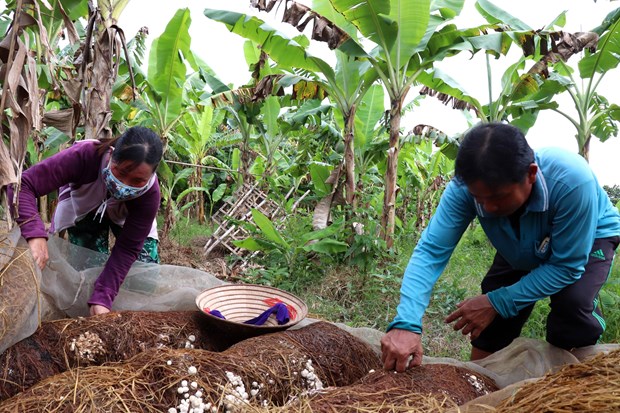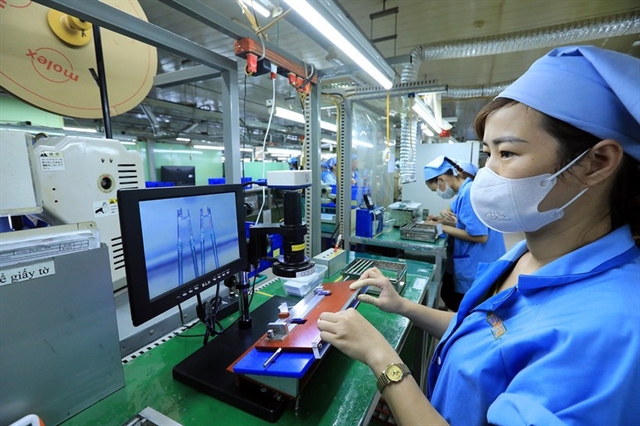 Society
Society

 |
| A couple in Thốt Nốt District, Cần Thơ City grow mushrooms on straw. — VNA/VNS Photo Thu Hiền |
CẦN THƠ — Mushroom farmer Trần Văn Việt, of Thốt Nốt District in the southern city of Cần Thơ has grown mushrooms on straw for about 20 years.
He grows about ten crops of mushrooms each year, and uses about 200 tonnes of straw yearly.
Each season, he harvests about 700kg of mushroom, raking in profit of VNĐ5-20 million per season.
After harvesting mushrooms, the used straw will be sold to gardeners who use it to cover the roots of trees like apricot, lemon or grapefruit.
“Gardeners have a huge demand for used straw,” Việt said.
In Cần Thơ City, over one million tonnes of rice is produced each year, generating about one million tonnes of straw but just half of the straw is reused for growing mushrooms, composting or making animal feed.
The price of straw is not high, only about VNĐ300,000 per ha, and the reuse of the material has contributed to increasing the value of rice crops, reducing air and soil pollution.
Seeing an increasing demand for straw in livestock and farming, in 2020, Toàn Phát Agricultural Cooperative in the city’s Cờ Đỏ District bought eight straw rolling machines and purchased straw from fields in localities of Cần Thơ, Đồng Giáp and An Giang.
Nguyễn Thanh Hồng, Chairman of the Board of Directors of the co-operative, said that each year the cooperative produced about 350,000 - 500,000 rolls of straw but demand was much higher.
Since the co-operatives had straw rolling machines, they bought more straw from local farmers, so the farmers preferred to sell the straw instead of burning it in the fields, Hồng said.
Also at the co-operatives, straw is used to make organic fertiliser.
Hồng said that after harvesting, organic fertiliser was left in the field. The remaining fertiliser can continue to be used for the next crop.
Thanks to the use of organic fertilisers, Hồng’s co-operatives could reduce the amount of inorganic fertilisers and reduce the cost of rice production.
In the past, farmers also composted organic fertiliser from straw but mixed it by hand, because the amount of fertiliser was small and it was only used to fertilise plants, he said.
Hồng said that he planned to invest in composting from straw with mechanisation.
“It is hoped that the amount of fertiliser will meet rice production, helping to reduce the amount of inorganic fertiliser,” he said.
According to Associate Professor and Dr. Nguyễn Văn Hùng from the International Rice Research Institute, organic fertiliser products are used as soil supplements instead of chemical fertilisers.
“Since a large amount of straw is used to make organic fertiliser, it will greatly increase the value of rice production. Thus, straw becomes a "genuine product", not a by-product,” he said.
The application of mechanisation in composting used straw together with cow manure and microbial fungi will shorten the composting time (about 45 days) compared to composting straw taken directly from the field.
The application of mechanics in mixing fertiliser is more productive than manual work (3 tonnes per hour). The quality of composted straw is the same as popular organic fertilisers in the market. However, the price of organic fertiliser made from straw is just half of the price.
Đồng Văn Cảnh, leader of the Green Agriculture Co-operation Group in Thốt Nốt District, said that the group was sponsored by IRRI to make fertiliser from straw.
He used organic fertilis on his family's chili garden. Seeing the effectiveness of the organic fertiliser, he then sold it to the market.
Cảnh said that he harvested four kilos of chili per square metre.
"Using organic fertiliser produced by myself, I feel reassured while the fertiliser is much cheaper. After finding its effectiveness, I introduced it to other farmers. The members of my co-operative group all agreed to contribute capital to produce organic fertiliser from straw, both taking advantage of the discarded straw and reducing the burning of fields," said Cảnh.
Lê Thanh Tùng, Deputy Director of the Department of Crop Production under the Ministry of Agriculture and Rural Development, said that composting rice straw to make organic fertiliser could add value to the rice chain and create more jobs for people.
“Especially, in the context of high fertiliser prices, the creation of organic fertiliser from rice straw helped reduce the pressure on rice production costs. Producing organic rice from organic fertilisers that are made from rice by-products will achieve environmentally friendly standards,” he said.
More value added was created in rice production, he said.
"If cooperatives use organic fertilisers made from straw, they join a circular agriculture and a further ecosystem preservation," Tùng said.
“Circular agriculture or the reuse of straw is a trend that scientists and researchers encourage people in the Mekong Delta to apply. This will create dual benefits for the rice growers and the environment,” he said. VNS




